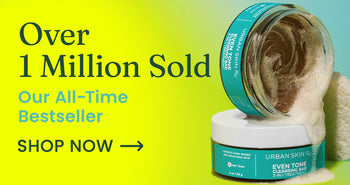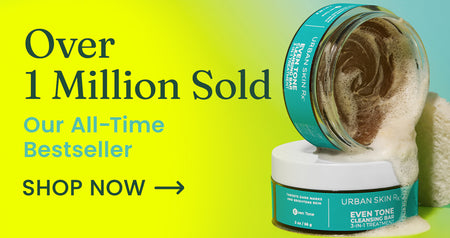Post-Inflammatory vs. Hyperpigmentation: What’s the Difference?

Have you ever stopped to check yourself out on your way past a mirror and loved everything except, maybe, for some frustrating dark spots or blemishes? Yeah, we've been there, done that.
Especially among those of you who are gifted in the melanin department, hyperpigmentation is a really common skincare concern. It can get in the way of that bright, even-toned glow you're after and make you feel like you need to turn to heavy cosmetics and foundations to hide it, especially when it doesn't seem to fade over time.
When it comes to hyperpigmentation, there are a few different types and causes, and one of the most common is post-inflammatory hyperpigmentation (PIH). If you're wondering what these dark spots are, what causes them, and how these two types of blemishes are different, don't worry — we're here to break it all down for you.
What Is Hyperpigmentation?
You know what hyperpigmentation is visually, especially if you're reading this article looking for a solution — it's those frustrating dark spots and splotches that may be standing between you and a skin tone that looks better than an Instagram filter. These marks form when your skin produces an excess of the pigment called melanin — hence, hyper (“more”) pigment (duh).
Melanin is what gives our skin its gorgeous, unique color. But sometimes, your skin cells can overproduce melanin, affecting your skin's natural tone in less-than-flattering ways. While all skin types and tones are susceptible to melasma, it's more common in people with skin of color.
A wide variety of things can cause hyperpigmentation. Sun exposure can cause damage over time, resulting in what we usually call “sunspots.” Often hyperpigmentation due to UV rays is just a cosmetic issue — but it's worth checking out if you notice warning signs like an irregular shape to your hyperpigmentation, raised edges or a noticeable change in the shape or size of the blemish.
Hormonal changes can also cause hyperpigmentation. Something like melasma, a form of hyperpigmentation, is also known as the “mask of pregnancy,” which occurs most commonly due to changing hormones during pregnancy. But other things can affect your hormones, too, such as certain health conditions, birth control and menopause. There are other pigmentary disorders, too, other than melasma. If you don't feel that the common causes of hyperpigmentation seem to apply to you, or you just want clarity, it might be time to visit a dermatologist.
Why Is It Called “Post Inflammatory” Hyperpigmentation?
Post-inflammatory hyperpigmentation is a type of hyperpigmentation, but rather than having a wider range of causes, it happens for one specific reason: damage to your skin.
Annoyingly, the causes of PIH don't even need to be that significant!
PIH can be common in areas of the body that experience friction, like your inner thighs or underarms. Repeated friction and rubbing can irritate your skin and, over time, lead to an excess of melanin production, which causes PIH.
Often, PIH happens after breakouts. If you struggle with dark marks that take the place of your pimples and blemishes even after you've doused yourself in Salicylic Acid and healed your breakout, this is a form of PIH. Acne scars, too, can be down to PIH.
Some skin conditions, such as eczema, psoriasis, erythema, lichen planus and severe cases of contact dermatitis, can lead to PIH, too. It's frustrating if you're prone to PIH because it can feel like another roadblock thrown in the way of your journey to clear, glowing skin as soon as you solve the initial problem.
What Can You Do About Dark Spots?
The first thing you can do about PIH and general hyperpigmentation is be aware of your risk level! If you have close relatives who are prone to discoloration, likely, you will too. If you have darker skin, you're more vulnerable to hyperpigmentation. If you're prone to any condition that may injure, irritation, inflame or otherwise damage your epidermis, PIH is a risk for you.
Whether you're reading this because you're already struggling with hyperpigmentation or PIH or because you're worried you may develop it in the future, there are several things you can do to minimize the appearance of dark spots and prevent them from happening — or coming back.
Prevention
The best thing you can do for hyperpigmentation and PIH is to prevent them from happening in the first place. While you can't exactly just ask your melanocytes to chill out, there are some basic things you can do to help prevent environmental damage that can lead to hyperpigmentation.
First of all, you'll want to be religious about SPF application. Sunscreen can help prevent a wide range of pigmentation disorders because it will reduce the damage that UV rays can do to your skin over time.
Our Complexion Protection Moisturizer with SPF 30 is formulated with both chemical and mineral additives while still being suitable for all skin types — say goodbye to the unwanted white cast you experience with other mineral broad-spectrum sunscreens. This lightweight, non-pore clogging SPF 30 moisturizer provides both daily hydration and sheer sun protection for all skin types and tones.
You can also wear protective clothing for additional sun protection in extreme weather. We know that sounds like a downer, especially if you're a dedicated beach babe, but picture this: a wide-brimmed sun hat that gives you mysterious, black-and-white movie star vibes. Yeah, you're welcome.
Exfoliation
Whether you're already dealing with PIH or hyperpigmentation or trying to prevent a breakout from becoming a lingering problem, working exfoliation into your daily routine can help. Our BrighterDays™ Dark Spot 8% AHA Polish is the dual-action exfoliating polish and treatment mask you need to buff, smooth and brighten your uneven skin — or to help clear your blemishes before it settles into PIH.
It's formulated with Glycolic Acid and Lactic Acid, which are Alpha Hydroxy Acids that help break down the bonds between your skin cells to remove older, duller skin and reveal a clearer, clearer, more even complexion. Although it's tempting to think that exfoliation might slough away your hyperpigmentation, you'll need to regularly use an AHA polish like this one to see results.
Chemical Peels
On the more extreme end of the chemical exfoliation spectrum are chemical peels. Chemical peels use a stronger-than-normal solution of chemical exfoliants that, when applied topically, help your dermal layers to separate and shed. There's a wide range of treatment options when it comes to chemical peels, ranging from at-home solutions like our Medspa Edition: Complexion Correction Peel Pads to seriously hardcore, professional treatments.
Stronger chemical peels penetrate your dermis to help address hyperpigmentation or postinflammatory pigmentation at a deeper level. While you're not likely to see instant results, a deep chemical peel may lighten hyperpigmentation after one treatment.
Brightening Ingredients
Brightening ingredients are key for evening your skin tone! Tyrosinase is a necessary part of the process by which your melanocytes create melanin — the pigment that gives your skin color and causes hyperpigmentation.
Some ingredients, like Kojic Acid, Azelaic Acid and Hydroquinone, can help minimize the appearance of hyperpigmented areas. These topical miracle-workers can help to improve the appearance of both hyperpigmentation and PIH.
Our Even Tone Super Glow Serum is formulated with Kojic Acid — one of those all-important ingredients that can help brighten and even out the look of your complexion more effectively. It also makes use of Vitamin C and Ferulic Acid, both of which are powerful antioxidants.
Antioxidants
Antioxidants like Vitamin C and Ferulic Acid can also help with hyperpigmentation and PIH! These damage-fighting powerhouses help support your skin against sun damage and other environmental interference that may lead to dark spots. They can also have a brightening effect on dull, uneven skin.
In addition to getting your antioxidant boost from our Even Tone Super Glow Serum, you can also use our Retinol Resurfacing Treatment Pads. You probably know Retinol as a superstar anti-aging ingredient — but did you know it's also great for resurfacing your skin and reducing the appearance of hyperpigmentation? Particularly if you struggle with PIH due to breakouts, Retinol can help to reduce acne and instances of PIH following it.
That's because ingredients like Retinol and its more powerful relatives Tretinoin and Retinoids are — you guessed it — powerful antioxidants, which can help neutralize damaging free radicals before they can start aging your skin… or causing dark spots and hyperpigmentation.
What's the Difference in Treatment for Hyperpigmentation?
We get it — all of those suggestions on how to improve the appearance of hyperpigmentation and PIH sound pretty similar, right? That's because, by and large, any topical treatment that works for PIH will work for hyperpigmentation, too.
The main difference is that because hyperpigmentation has a wider range of root causes, treating hyperpigmentation topically is not going to be the end of your epidermal journal. If hormones are causing dark spots, you'll need to speak to a doctor about whether there's anything you can do about that. If your hyperpigmentation is due to sun exposure, it's important to work on preventing further damage.
PIH also tends to be more short-term in general. It's likely to fade on its own, even without treatment. On the flip side, hyperpigmentation may be a long-term situation, and it's possible you'll need to look to more heavy-duty solutions like laser therapy or laser treatment to really even out your complexion.
In Conclusion
While hyperpigmentation and post-inflammatory hyperpigmentation are members of the same family and have a lot in common, there are actually some key differences when it comes to the causes of these frustrating skin conditions.
There are things you can do to help improve the appearance of both, but it's worth being aware of the differences so you can have realistic expectations! While post-inflammatory hyperpigmentation is likely to clear up on its own over time and should do so even more quickly with the aid of a great skincare regimen, some forms of hyperpigmentation can be a little deeper and a little more long-term.
Engagement Manager



